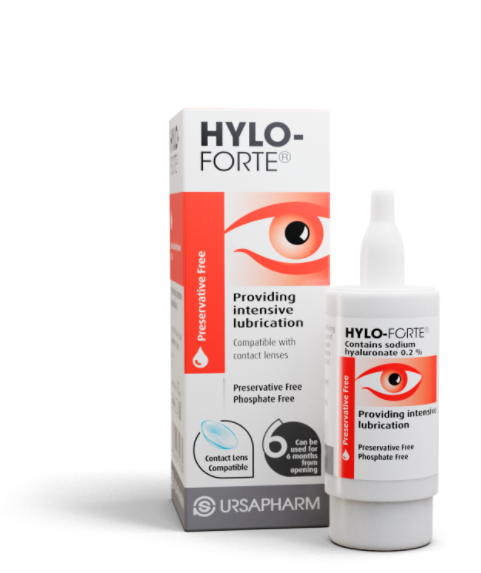Below you can see the most frequently asked questions from our patient seminar which took place 31st July 2021.
If you were unable to attend our patient seminar you can watch the guest speaker’s talks and clinic tours here.
Our tears – the tear film is a very complicated structure with many components that all need to work together, if one of the components isn’t quite right, then the body tries to compensate itself. If you have the type of dry eye that is evaporative, (and over 80% of all dry eye is the evaporative type) then as the name suggests the tears evaporate too quickly from the surface of the eye. Because the eye is very sensitive it instantly sends a message to produce more tears, but these tears are a different recipe and are too watery, so just spill out of the eye and onto your cheek. By using eye drops specifically for evaporative dry eye you can slow the evaporation and reduce this reflex response. (You may also need to consider some lid hygiene techniques to ensure that the meibomian glands are working as they should be).
Our tears are constantly forming and draining from our eyes. The drains are small openings in the corners of our eyelids near our nose called puncta. If you are not producing enough tears, you can purposefully block them up using plugs to try to retain more tears on the eye. They are very easy to fit, a Specialist Optometrist can usually do this for you.
You can’t overuse preservative free lubricating eye drops. If you are taking more than 8 – 10 drops per day, it would be worth speaking with your Optometrist as there may be a more suitable alternative. If you are using preserved lubricating drops, it is recommended that you don’t use them more than 4-6 times a day as the preservative can irritate your eyes and make the symptoms worse.
When we concentrate on driving or even as a passenger, we often blink less which will dry out our eyes. If you suffer from dry eyes, it’s worth using your drops before you set off (As long as your drops don’t affect your vision, in which case allow time for it to clear before driving off). Other things to consider are turning the air vents away from your face, or better still turn them off. Both hot and cold air will dry your eyes if directed directly at them. Air conditioning will have the same affect so keep it to a minimum on a hot day. Sunglasses will act as a bit of a barrier if you really need to use it. Remember to take regular breaks and keep hydrated too (if you can).
Rosacea is a chronic inflammatory condition that affects facial skin. It is commonly associated with flushed cheeks, but can also affect the nose, chin, forehead and eyelids. If the eyelids become inflamed, then this can affect tear production and result in the symptoms of dry eye disease. If you have rosacea make sure you mention it to your Optometrist as early changes may be occurring in your eyes.
IPL stands for ‘Intense Pulsed Light’. It is a treatment for meibomian gland dysfunction (MGD) which can cause dry eye disease. IPL uses polychromatic light, which simply means light with several different wavelengths, (between 500-1200nm) and is applied to the skin in several locations, usually below and to the temporal side the eyes. It works by reducing inflammation and helps to stimulate the meibomian glands to their normal function. A course of 3 or 4 treatments is usually required over several weeks. IPL has been used extensively in dermatology for the treatment of rosacea and is now becoming more widely ultilised in ophthalmology for MGD where studies suggest improvement in approximately 80% of patients.
In the first instance we would recommend consulting your eye care practitioner who will be able to give you clinical advice or refer you to a specialist if needs be.
Following a consultation with your eyecare professional:
Sharing lived experiences is a great coping strategy for people living with dry eye disease. There are a number of not for profit organisations that facilitate support groups and conversations for among dry eye sufferers. These include:
USA
– The Dry Eye Foundation https://www.dryeyefoundation.org/
UK
– BSSA https://www.bssa.uk.net/
– Facial Palsy UK https://www.facialpalsy.org.uk/
Ireland
– BSSA Chapter https://www.bssa.uk.net/
– NCBI https//www.ncbi.ie
When you have dry eyes, everything surrounding you seems to make them worse. Your eyes are already irritated, so protect them from wind, dirt, dust, and pollen. Sunglasses play an important role here. Consider the following when selecting a pair of good sunglasses:
Protection level: This refers to blocking UV light from getting into your eyes. You will want maximum coverage for both UVA and UVB light. The tint of the lens and the degree of darkness do not factor into the level of UV protection
Tint: Grey lenses will block light equally across the colour spectrum and will alter your colour perception least. Dry eyes are usually sensitive eyes. A darker lens to increase comfort.
Style: Choose a wraparound style, a fit over sunglass, or a frame with large temples for best coverage. These styles provide the best protection to your eyes from elements like wind, dust, and pollen.
Look at the ingredients rather than the brand. Cosmetics can change their formulation and something you previously tolerated might cause a reaction if the formulation changes.
Avoid preservatives as these can irritate nerves on the surface of the eye.
The most important thing to remember is to take it off completely every night. Leaving remnants of mascara, eyeliner, and eye shadows becomes the perfect home for bacteria to flourish around your eyes and cause the eyes to be red and irritated.
It’s not uncommon to sleep with your eyes slightly open which can leave your eyes feeling sore, gritty, and uncomfortable in the mornings. Sometimes using a lubricating eyedrop or an ointment at bedtime is sufficient. Some patients find sleeping in an eye mask helps, whist others prefer to tape their lids shut with surgical tape. Sleeping with a humidifier in the bedroom can also keep the surrounding air moist and less likely to dry out the eyes. Talk to your Optometrist about the best options for you.
EPA and DHA from algae or fish act exactly the same in the body – it doesn’t matter the source.
The advantage of fish-based sources over algae-based is that the dosage is more. In a perfect world they would be the same dosage, but it is not possible to get 2 + grams of EPA/DHA in algae form in a cost-effective way.
If a vegetarian is NOT willing to take a fish-based product, the vegetarian algae-based product is the way to go. The algae-based is the next best thing for people unwilling to take a fish-based product
In a double-blind randomized controlled study, results showed that a 3:1 ratio of EPA to DHA was very effective in changing the composition of the meibum after only 8 weeks of supplementation of a supplement containing 1680 EPA/560 DHA of re-esterified Omega-3 oil. In fact, in this clinical study, 70% of patients became completely symptom free in this study time frame and 100% of patients noted a decrease in the primary complaint of dry-eye symptoms.
The experts all agreed that they would only recommend a product with the science to support it. They would recommend either PRN Omega 3 sold as either; ‘De 3 Omega Benefits’ (US) or ‘Omega Eye’ (UK & Ireland) or Science Based Health ‘Hydoeye’ (US)


